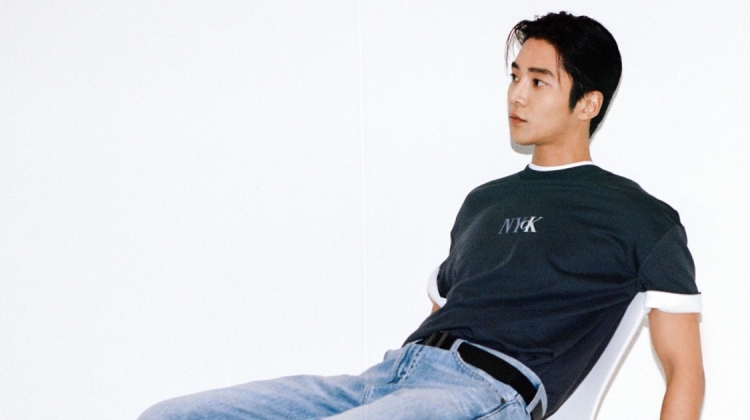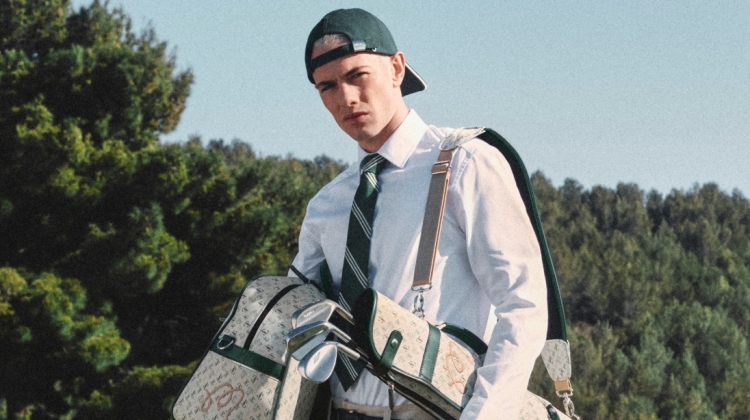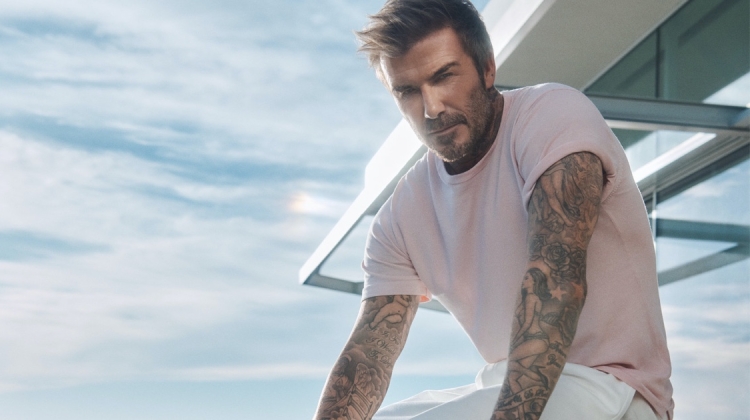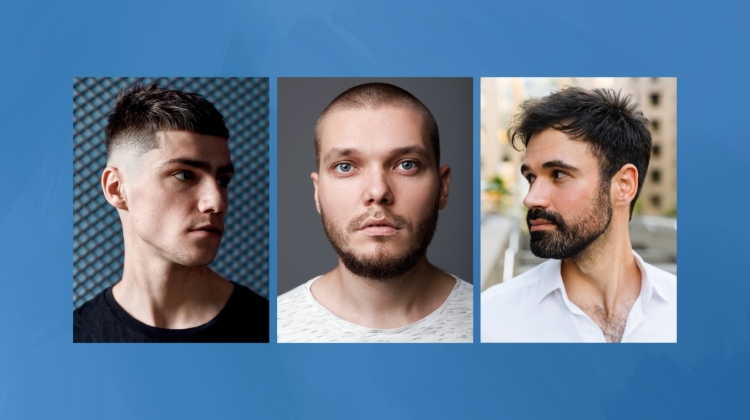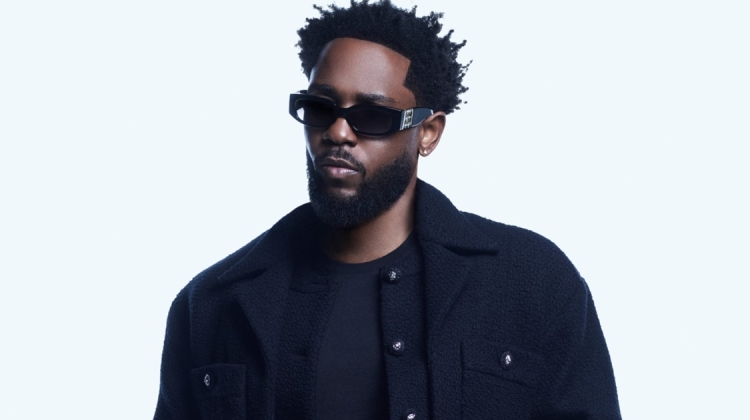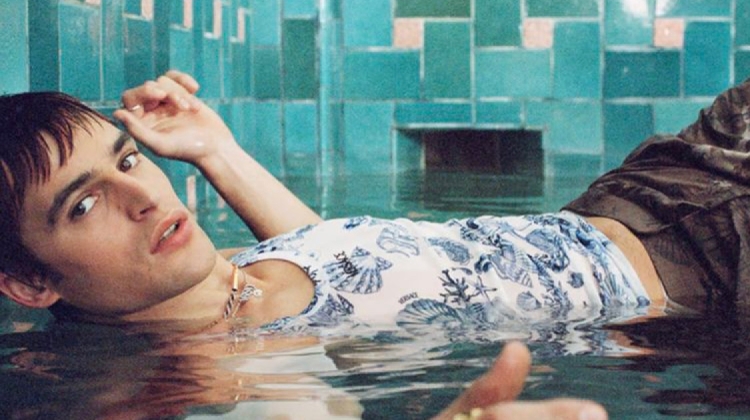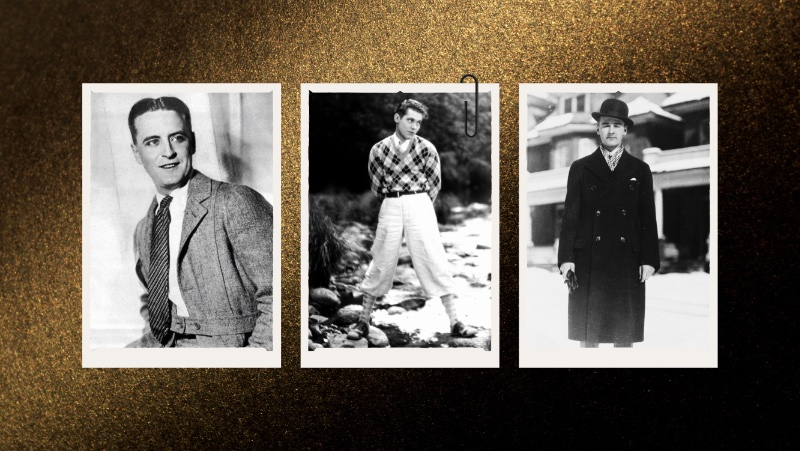
1920s men’s fashion marked a pivotal chapter in style history. The Roaring Twenties weren’t just an era of flappers and jazz. Post-World War I, the air seemed ripe for reinvention.
Gone were the days of somber, buttoned-up ensembles. Men shook off the dust of tradition, opting instead for clothes that gleamed with bright hues and dashing patterns.
1920s Men’s Fashion: The Social Fabric
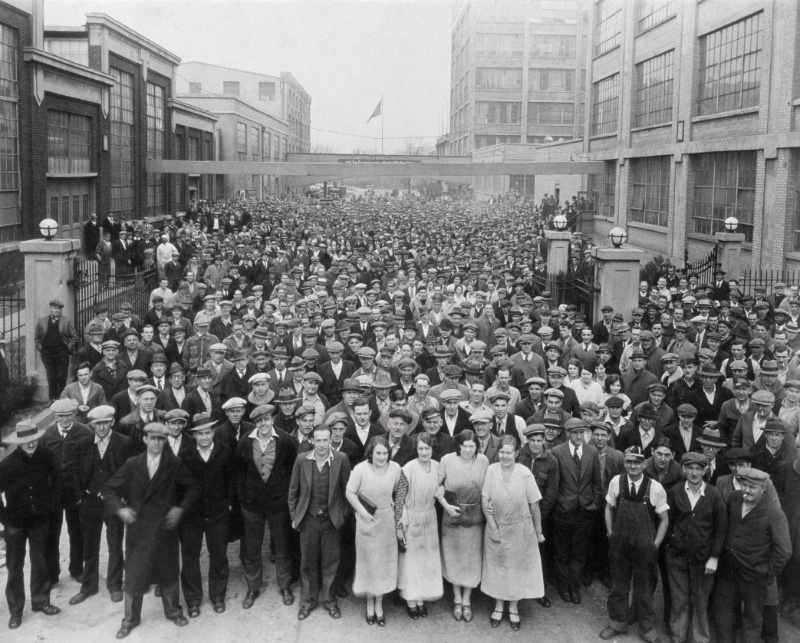
The seismic shift in 1920s men’s fashion wasn’t merely aesthetic. It signaled a social evolution. A booming economy, fueled by industrialization, brought tailoring into the purview of the everyday man.
No longer the exclusive domain of the well-heeled, stylish suits graced the shoulders of citizens from all walks of life. The democratization of fashion had commenced.
In an era without social media, department store catalogs were influencers. Distributed far and wide, these catalogs were the rural man’s ticket to cosmopolitan chic. Thus, the seeds of individualism in fashion were sown in the very fabric of America’s heartland.
Formalwear: 1920s Men’s Suits
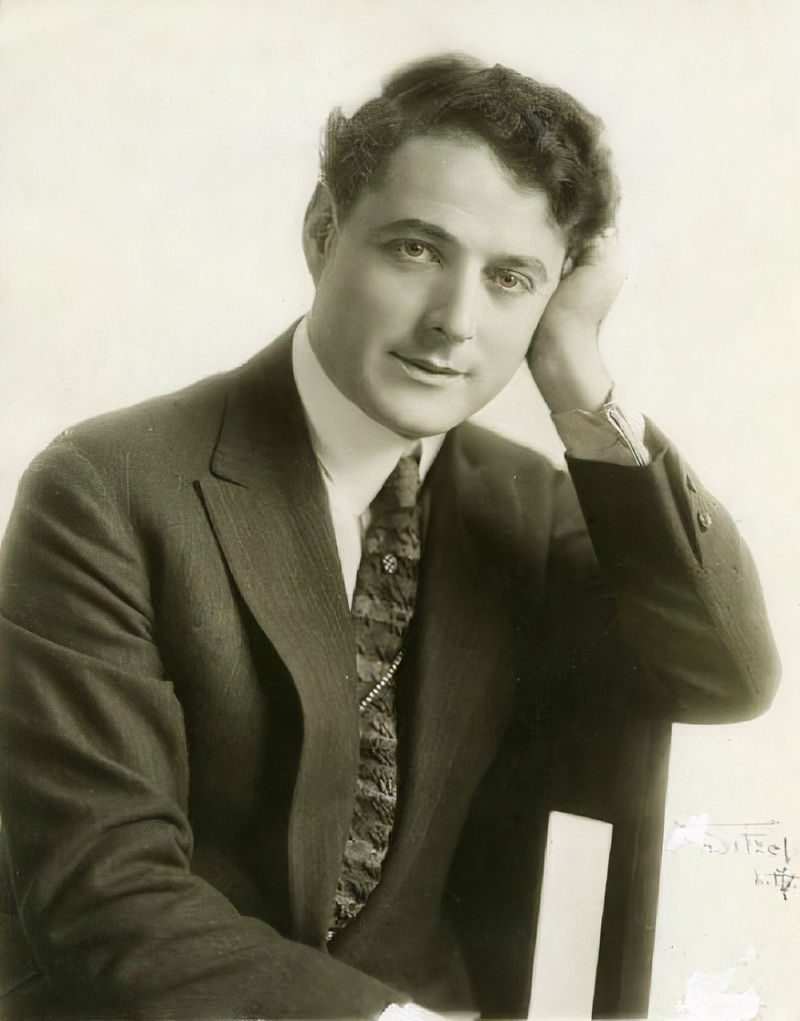
In the 1920s, men embraced youthful sophistication, donning impeccably tailored suits that mirrored the style of F. Scott Fitzgerald’s characters. The decade celebrated sartorial experimentation, catering to traditionalists and avant-garde aficionados.
A Tapestry of Colors & Shapes
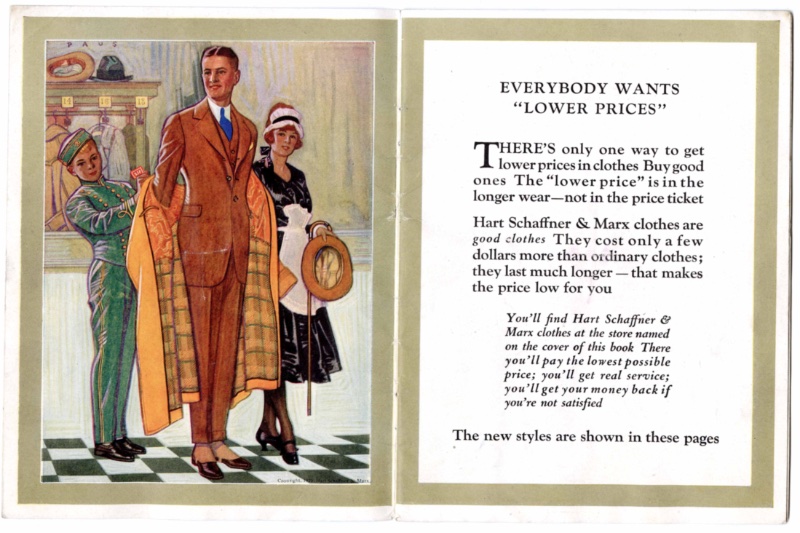
Men expressed their style through a vibrant palette of colors and shapes. Classic hues like navy, brown, and gray were accented by softer tones such as ivory, pastel blue, mustard yellow, and olive green. Seasonal shifts influenced these choices, with lighter shades in summer and darker ones in winter.
Jackets crafted from luxurious wool tweed and heavy wool fabrics featured natural shoulders, wide lapels, and flap pockets. Cinched at the waist, these tailored masterpieces boasted precise button placement, usually three or four on single- or double-breasted jackets, with notch lapels as a defining feature.
The Three-Piece Suit
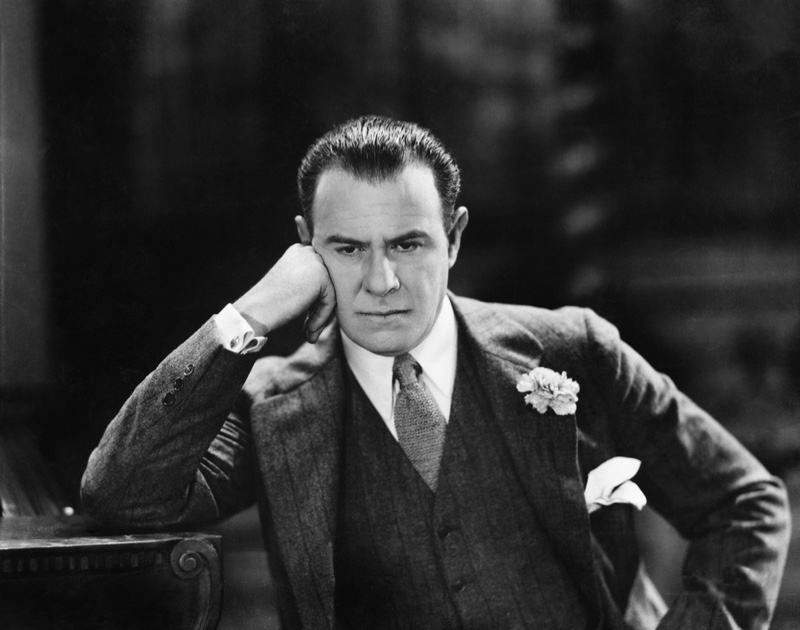
The three-piece suit, complete with a high V-neck waistcoat or sweater vest, was a must-have for the fashionable man. The colorful sweater vest became a golf course staple, a trend that persists today.
The Pinstriped Suit & Accessories
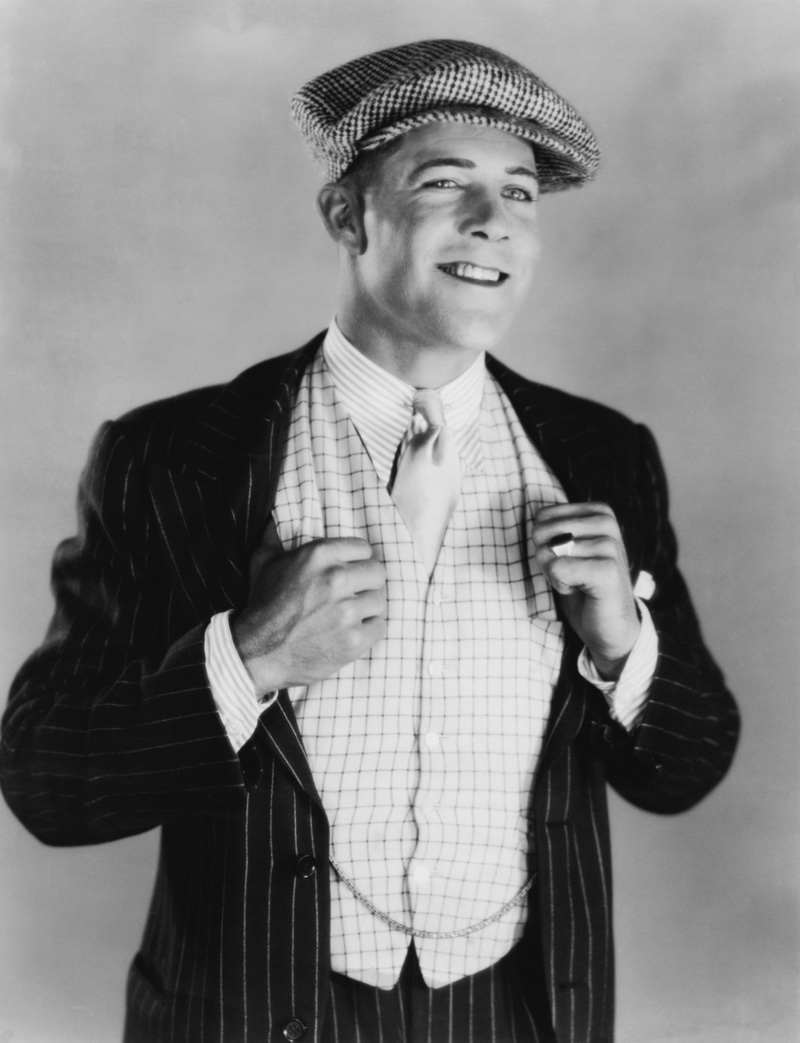
Pinstriped suits, white shirts, and striped neckties created sharp, go-to ensembles. Cropped suits, wide-legged trousers, fedoras, and spats completed the look.
The Somber Elegance of Black
Black suits were reserved for somber occasions, particularly funeral attire, as a cultural signal of mourning and respect. Wearing black elsewhere was a faux pas. Men favored nuanced shades like navy blue and charcoal gray for everyday outfits, distancing themselves from the gravitas of black.
Shirt Trends
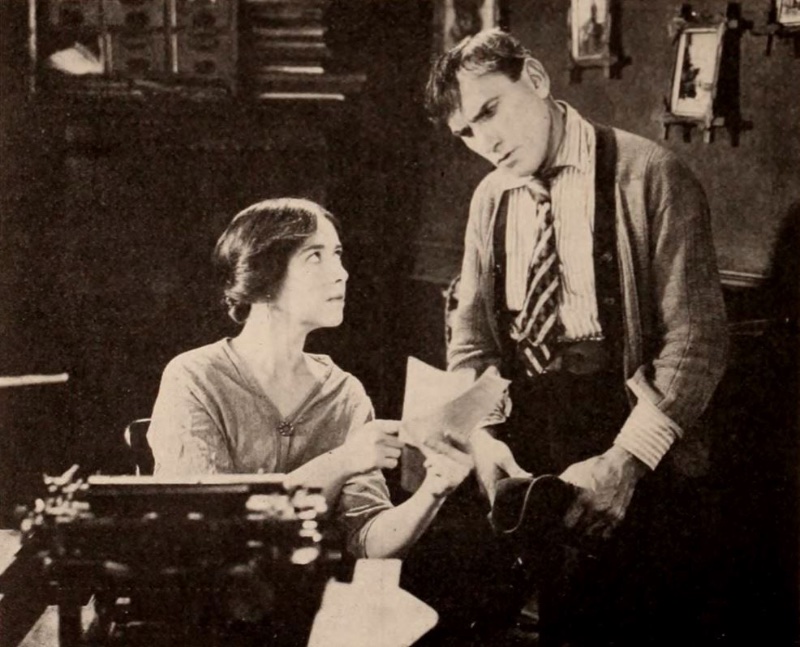
In a break from convention, the dress shirt opted for vivacity over sobriety. Stripes held sway as men combined vertical lines with solid hues to inject their flair into daily attire. The color palette was anything but monochrome, with daring splashes of pink and yellow.
Collars offered their choices, ranging from the round club variety to the free or pointed versions. The cultural impact of The Great Gatsby even lent prestige to the mandarin shirt, elevating it to a popular choice of the era.
Pants & Trousers
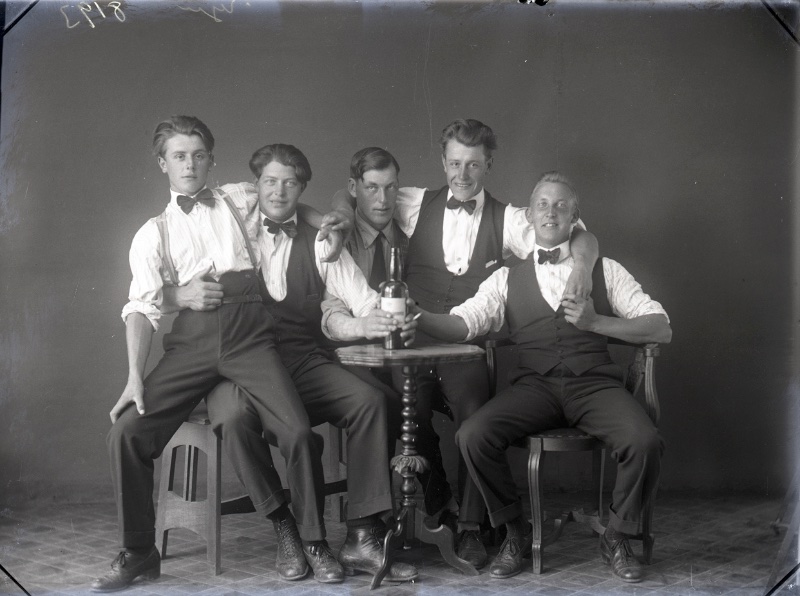
Traditional trousers were more than just a bottom half—they were a sartorial statement. Defined by cuffs and twin pleats at the waist, a crisply ironed front leg crease was the finishing touch. These trousers were cut to reveal the ankle, showcasing high-worn socks in solid or argyle patterns anchored in place by sock garters.
By design, these high-waisted trousers could be cinched with either a belt or suspenders. As the decade unfolded, pant legs evolved from narrow to a more generous width, reflecting a broader shift in men’s fashion tastes and comfort preferences.
Suit Accessories: Ties, Pocket Squares + More
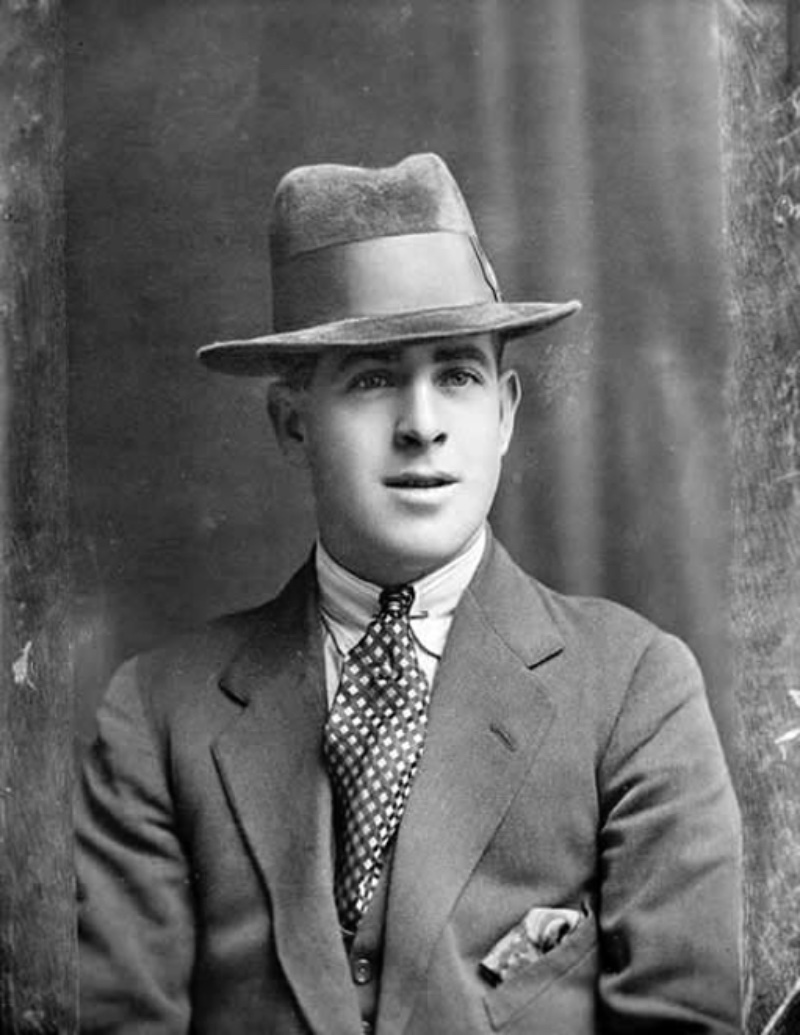
Bow ties and neckties were more than mere punctuation—they were statements. With a repertoire that spanned solid colors to stripes and even polka dots, these narrow, often shortened ties provided a burst of color in sync with the era’s lively shirts.
Beyond traditional ties, silk scarves became the avant-garde choice for neck adornment, offering a touch of bohemian flair. In this spirited age, gloves and pocket squares emerged as the small but significant details that articulated individual style.
Far from today’s muted palette, men of the 1920s were drawn to bright reds, counterbalanced by the soothing gravitas of dark greens and light browns. Elevating these outfits were the subtle accents of collar pins and cufflinks, making each outfit a curated expression of persona.
1920s Casual Attire
Sweaters
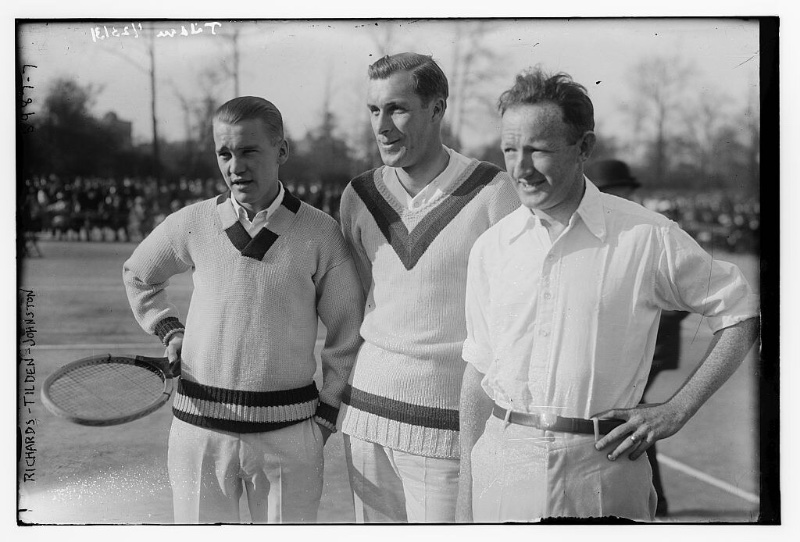
Sweaters emerged as a stylish and practical favorite amid the colorful tapestry of 1920s men’s fashion. The silhouettes gravitated toward V-neck pullovers and cardigans, some even venturing into buttonless, free-form designs with generous shawl collars. Far from muted, these garments often flaunted audacious patterns, awash in vibrant reds, blues, and yellows.
Crafted from wool or cotton, these sweaters are combined with dress shirts, trousers, and suspenders to complete the look. The result? An ensemble effortlessly transcended occasions, anchored by loafers that added the final fashionable flourish.
Shirts
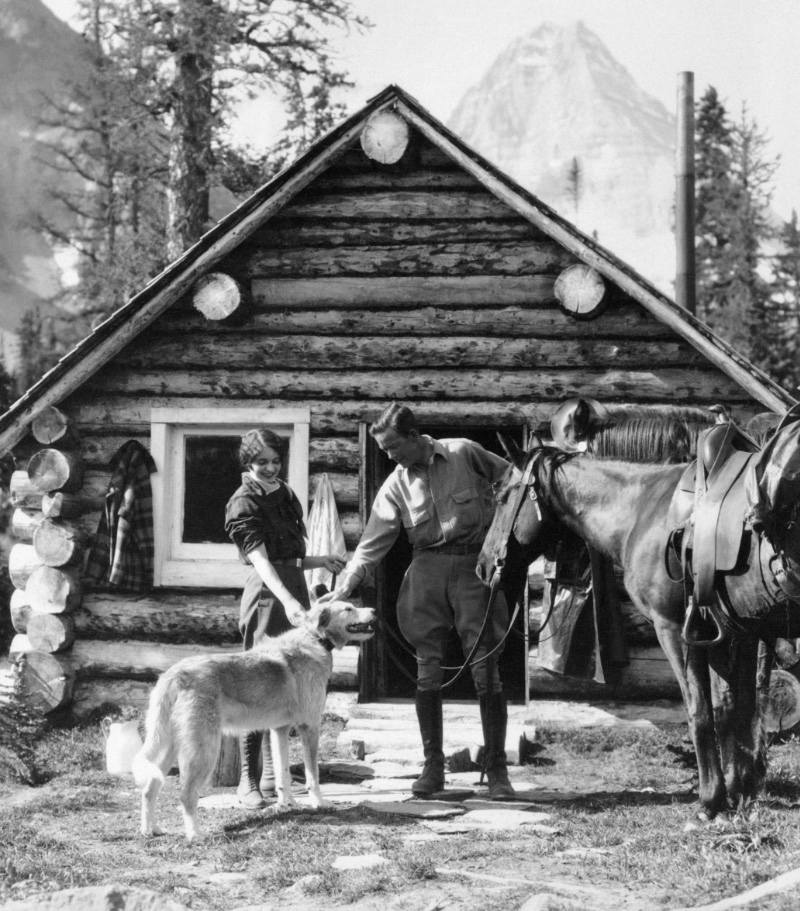
In the 1920s, men’s shirts prioritized comfort and functionality, featuring soft cotton or linen fabrics in uncomplicated colors like white, blue, brown, or grey. Collars diversified, offering straight-pointed and soft lapel styles that could open at the neck and secured by collar pins for a polished look.
Adaptable sleeve lengths suited casual and formal occasions, making these shirts versatile staples that seamlessly straddled the line between classic and contemporary.
The Country Jacket
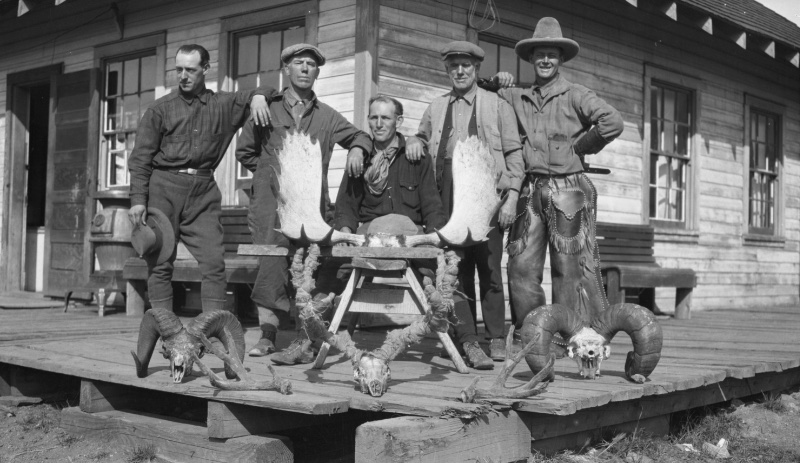
The country jacket was a versatile cornerstone in a well-curated wardrobe. Its hues drew inspiration from the landscape, showcasing earthy browns, deep greens, and nautical navy blues. Tailored with thoughtful features like leather buttons and slanted pockets, the jackets often boasted tweed fabric—a nod to their outdoor origins.
These jackets weren’t confined to rural escapades like hunting or fishing. Their intrinsic elegance allowed them to segue effortlessly into more sophisticated settings, especially when teamed with crisp trousers and a neatly collared shirt.
Pants
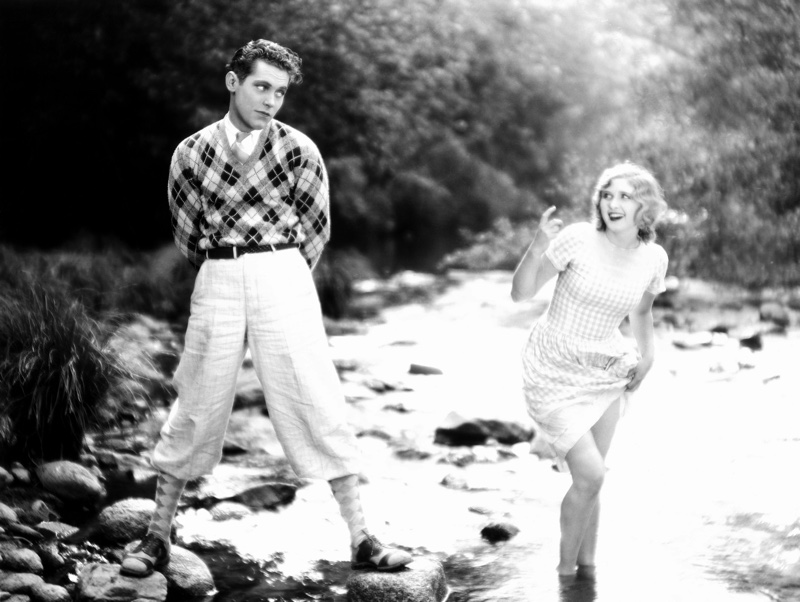
For relaxed settings, men donned knickerbockers (or plus fours), trousers that cut off below the knee with a generous cuff and were secured by suspenders or an elastic waistband. Available in brown, navy blue, plaid, and wide stripes, they were paired with high socks for added style.
As the decade closed, younger men favored “oxford bags,” slim-waisted trousers with roomy legs, often worn with sneakers or canvas shoes, signaling a youthful shift in casual attire.
White Pants
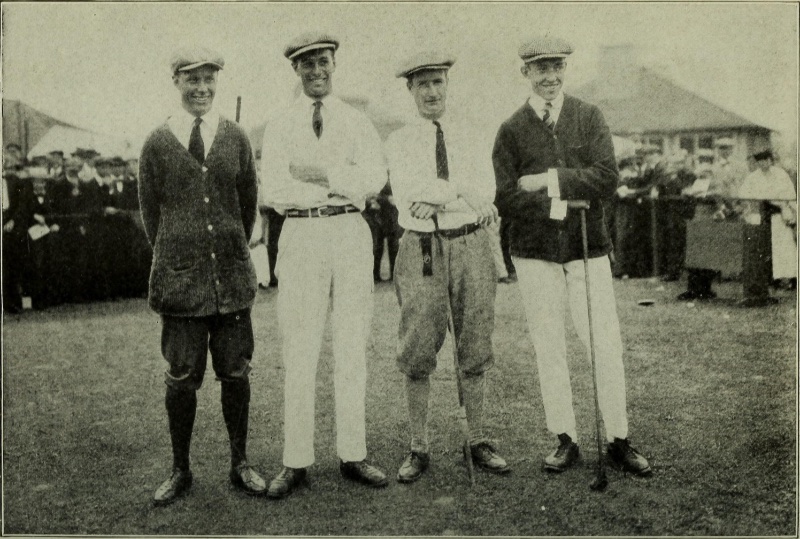
White pants, once a pre-war symbol of summer elegance among the affluent, democratized into a wardrobe essential for men of all classes and occupations by the mid-1920s. Visible in casual and formal settings, these light-colored trousers remained a staple in the sartorial lexicon of the era, enduring into the 1930s and 40s before fashion currents shifted anew.
Sleeve Cuffs & Armbands
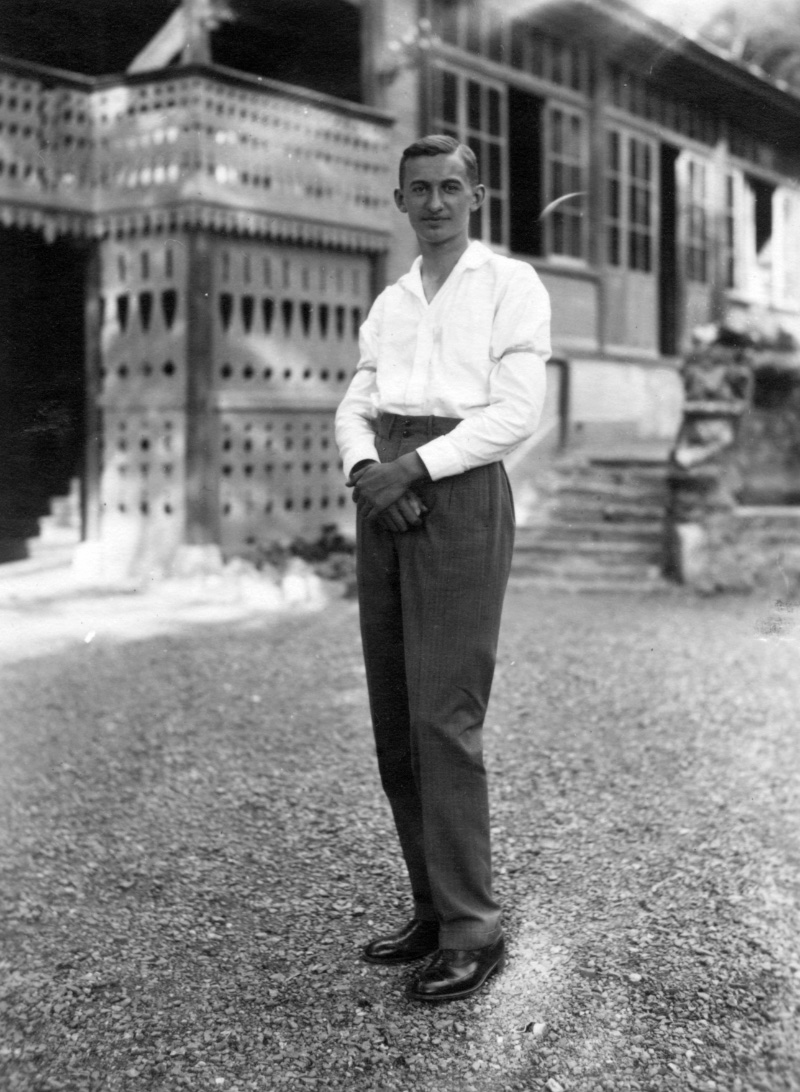
Sleeve cuffs and armbands, also known as sleeve garters, were the unsung heroes in 1920s men’s fashion. Armbands, often crafted from luxurious silk or sumptuous velvet, circled the wrist like a halo, infusing outfits with an extra layer of color and texture.
On the other hand, sleeve cuffs, generally made from wool or cotton, were designed for a roll-up feature, offering an air of casual sophistication. These pieces brought a nuanced blend of formality and relaxed elegance to the men’s wardrobe of the time.
Hats
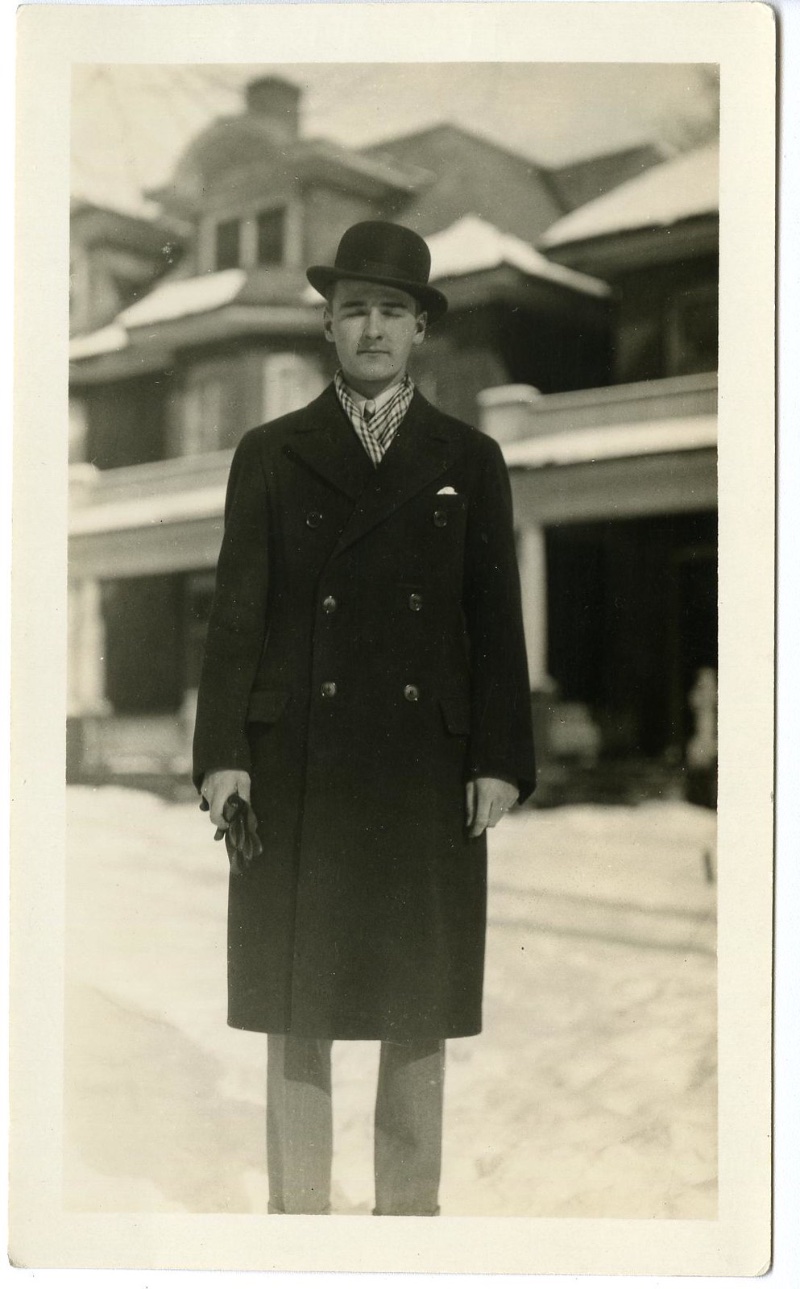
1920s hats were essential style declarations for men. Crafted from felt or straw, the versatile fedora reigned supreme alongside bowler hats and flat caps.
Top hats, homburgs, straw boaters, and Panamas were sartorial signatures, often embellished with feathers or ribbons for added flair. Twenties hair was slicked back or parted to fit with hats to complete a polished and expressive look that encapsulated the era’s regard for fine dressing.
Clothing Trends
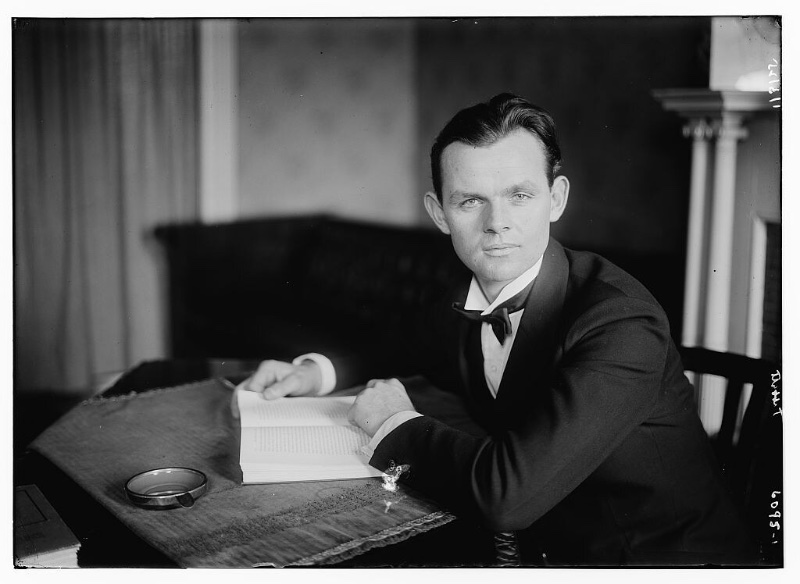
In the tumultuous 1920s landscape, fashion was a study in contrasts. While women’s attire dared the conventional, bursting into sequins and hemlines, men’s fashion retained a more cautious disposition.
Nevertheless, the Roaring Twenties didn’t leave men in sartorial stagnation. Distinct trends surfaced, veering from the traditional roadmap to etch a unique mark on the decade.
Detachable Shirt Collars
Men’s shirts featured detachable collars, allowing for effortless style changes to suit any occasion. Crisp white collars were ideal for formal events, while playful, diagonally striped fabrics suited lighter moments.
These collars required starching before wear, reflecting the era’s penchant for sharp lines and impeccable grooming.
Casual Dress
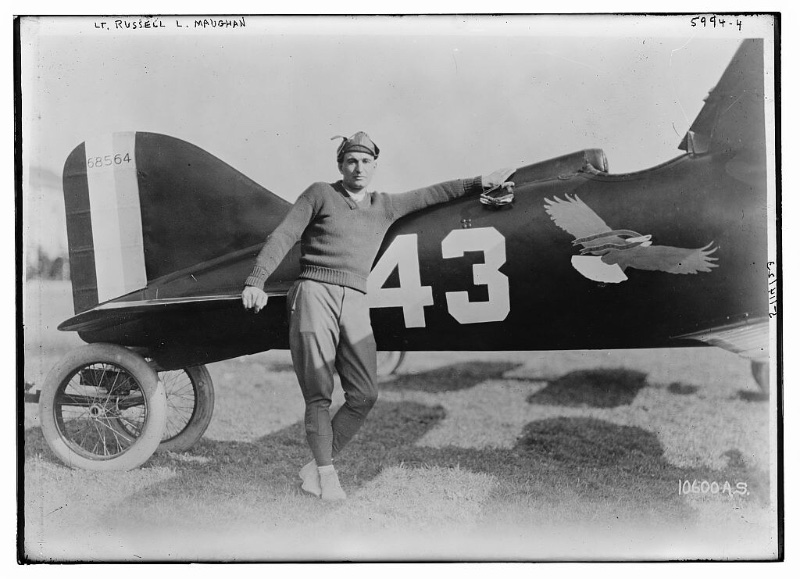
Sportswear made a grand entrance into men’s casual fashion, disrupting the sartorial norms of the time. Golf courses and boat decks became the backdrops for men dressed in cozy sweaters, pleated trousers, or more daring knickers.
Double-breasted suits, punctuated by expansive lapels, marked the era’s more formal aesthetics. Accents like fedoras and shoe spats elevated these ensembles, infusing them with flair.
Art Deco en Vogue
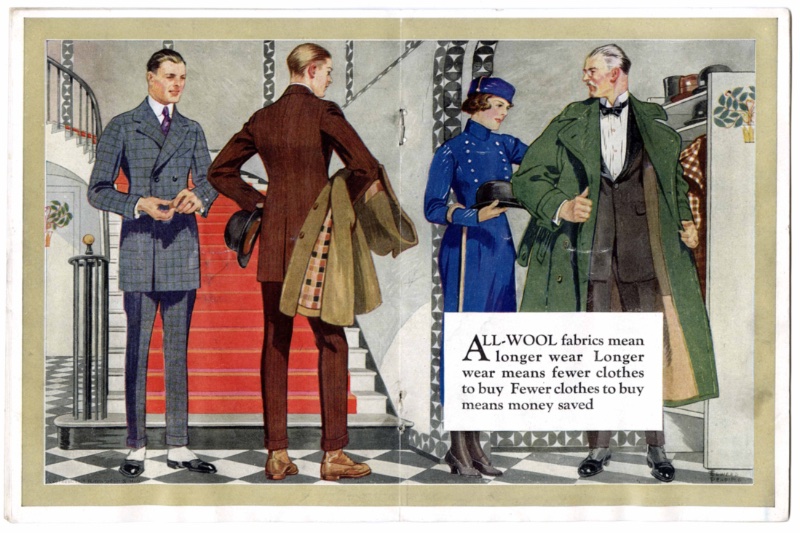
Influenced by the Art Deco movement, 1920s men’s fashion embraced lean, geometric forms. Suits featured broad shoulders and narrow waists, particularly in double-breasted designs, while bold patterns like pinstripes, checks, and geometric imprints made a statement.
Luxurious fabrics such as silk and velvet elevated sophistication. Accessories, including pocket squares, straw or felt hats, and two-tone shoes, served as extensions of personal style, contributing to the decade’s monumental impact on men’s fashion.
Collarless Vests
The collarless vest, featuring abbreviated collars and contrasting buttons, became a sartorial emblem of 1920s youth, challenging traditional suit rigidity. Worn with or without a shirt and tie, these vests were crafted from linen for summer soirées or wool for chillier affairs.
Versatile and eye-catching, the collarless vest carved out its identity in a decade known for its style dynamism.
Dressing for Formal Occasions
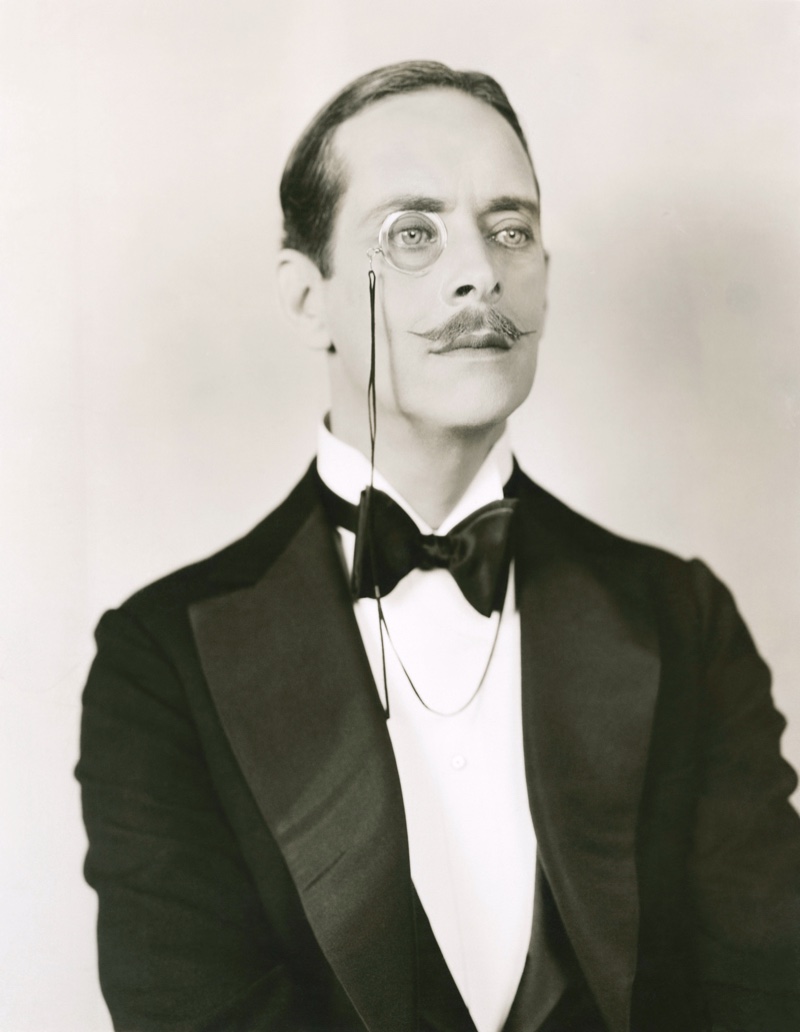
Men’s formal wear in the 1920s embraced tradition and innovation, featuring timeless ensembles like dinner jackets and morning suits alongside modern styles inspired by Hollywood icons Douglas Fairbanks and Rudolph Valentino. Their cinematic approach to formal dressing opened new possibilities, allowing men to navigate between classic and sophisticated looks for high-stakes occasions.
Morning & Evening Suits
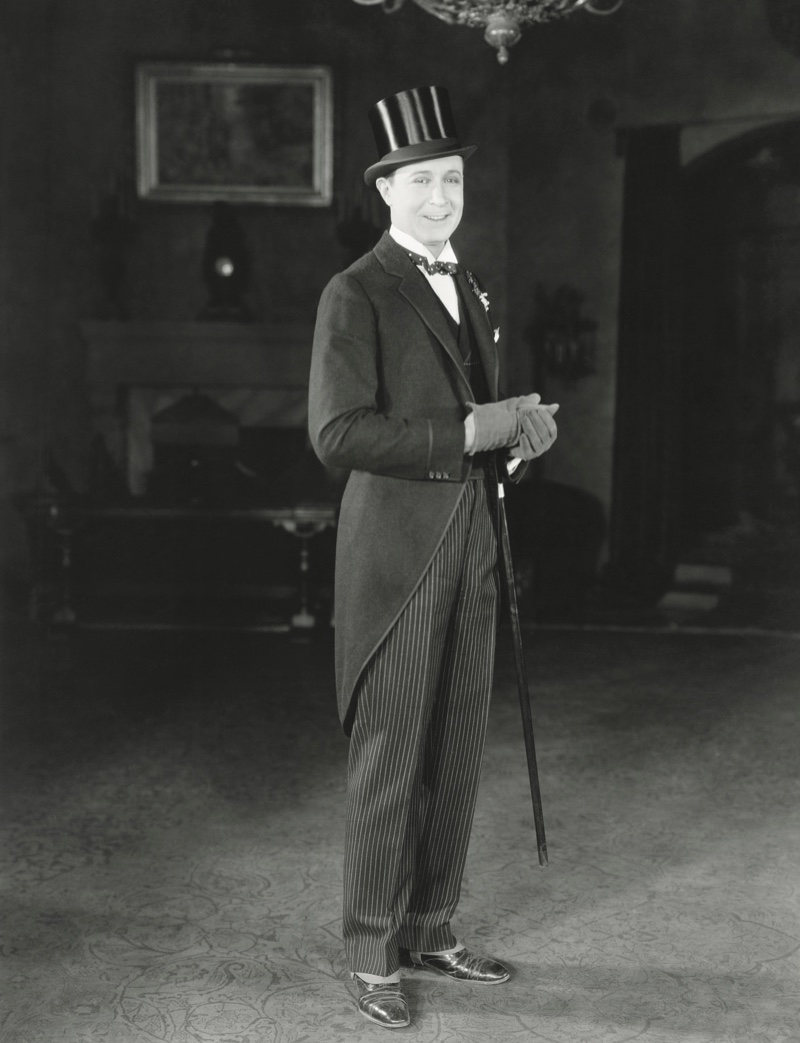
A morning suit was a curated masterpiece featuring a tailcoat with peaked lapels and higher button placement, a waistcoat, striped trousers, a shirt with a stiff wing collar and dress cuffs, and finishing touches like an ascot or bow tie, a pocket watch, and shoe spats.
In contrast, the evening suit offered elegant restraint, characterized by a classic tailcoat, conventional collar and cuffs, flat-front trousers, and a pleated shirt.
Footwear remained formal, with choices between sleek oxfords and high-shine black patent shoes, capturing the duality of extravagant flair and subdued sophistication in 1920s men’s wardrobes.
Special Occasions
Sleekly cut suits for special occasions featured wide lapels, double-breasted vests, and boldly patterned neckties. Accessories told their story, with felt hats, pocket watches, suspenders or braces, spats, canes or walking sticks, and gloves completing the ensemble.
Workwear & Functionality: A Class Divide
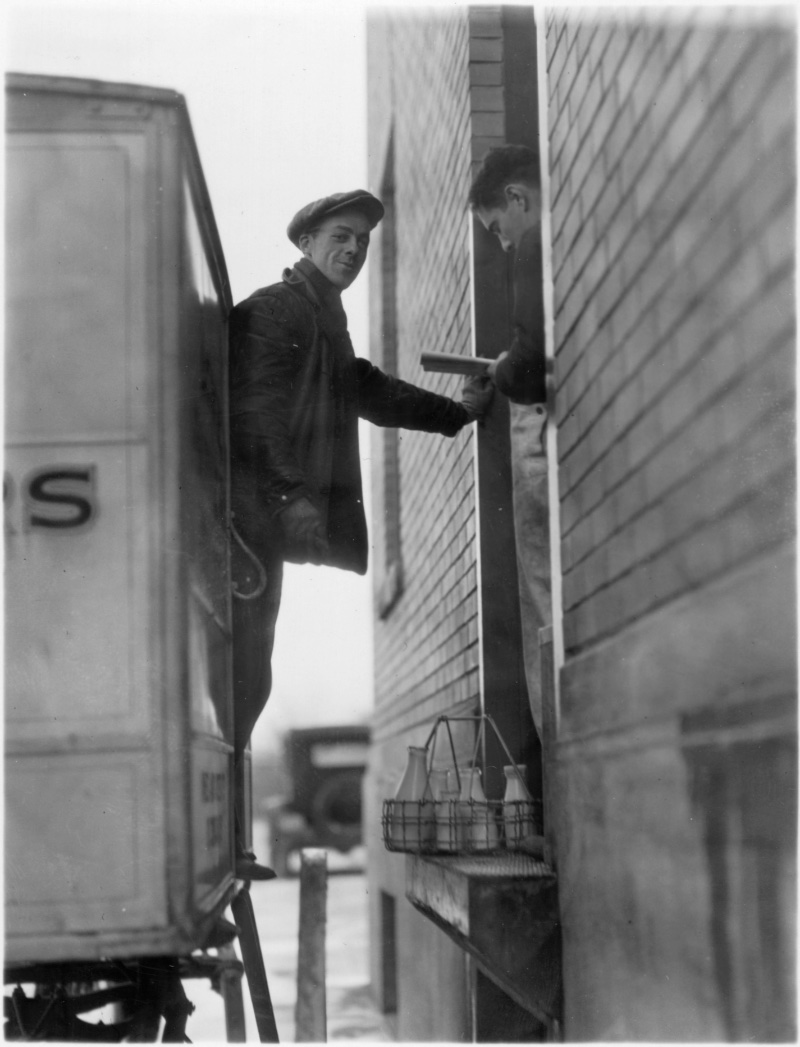
In 1920s America, men’s fashion mirrored the nation’s transition from rural simplicity to urban complexity. Middle-class men, aligning with their upward mobility, favored suits, ties, and hats made from premium, long-lasting wool and linen.
In contrast, working-class men chose utilitarian overalls or work clothes crafted from cotton or early synthetics, prioritizing functionality over fashion. This divergence created two distinct visual narratives: one of prosperity and evolving style, the other of timeless practicality, highlighting the complex interplay between fashion and social identity.
Workwear
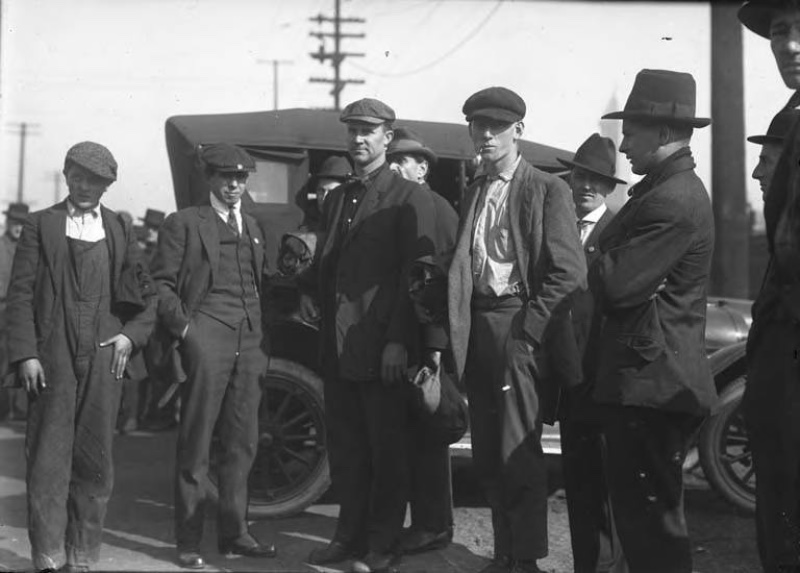
In a rapidly changing world, men’s workwear shifted to prioritize utility and effortless style. Breathable cotton twill and linen work pants and shirts provided a relaxed silhouette, while functional design elements like button-down chest pockets on shirts, roomy patch pockets, and expansive lapels on jackets added character.
Knit ties introduced texture, and the essential bowler or fedora hat completed the ensemble, balancing comfort and sophistication.
The Democratization of Style
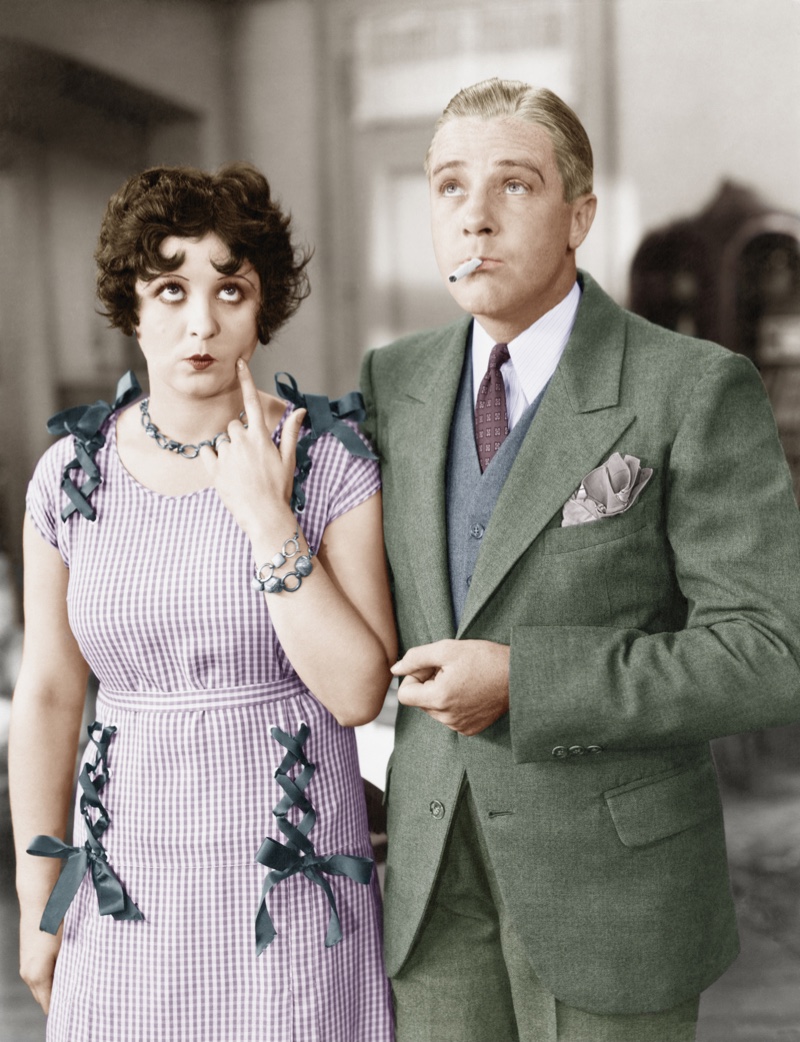
Department stores like Sears, Roebuck, and Montgomery Ward played a significant role in amplifying the 1920s-style lexicon. The American Dream drew individuals to thriving cities where the fashion industry flourished. Brands such as Brooks Brothers and Jos. A. Bank became navigators of tradition and innovation amidst this urban magnetism.
However, retailers’ interest in higher-margin unbranded merchandise posed a challenge. In response, brands leveraged newspapers, magazines, and radio to ask consumers, “Do you prioritize price or value?” This sparked a conversation about the ethos of consumption, emphasizing the timelessness of quality and authentic style.
Icons & Influencers
British Fashion & the Prince of Wales
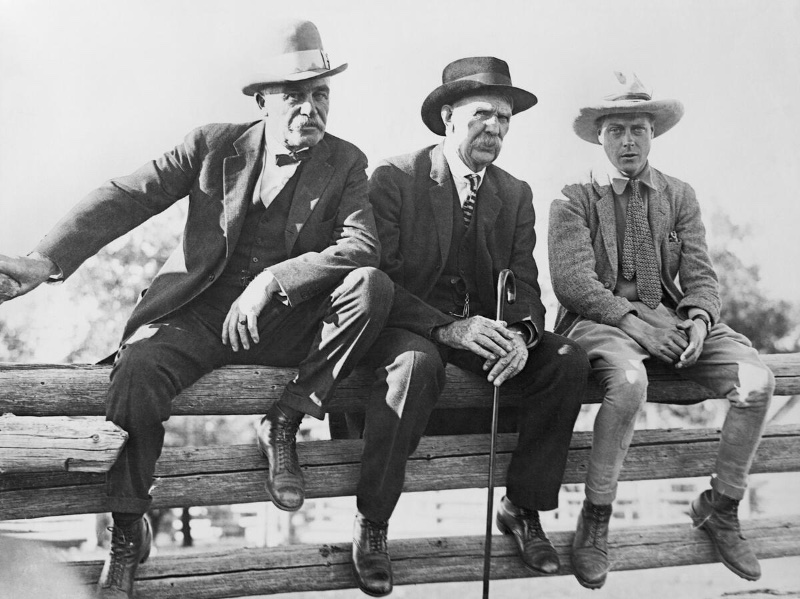
Deeply influenced by British style, American men in the 1920s embraced a dandyish flair with classically tailored linen, tweed, and wool suits accented by colorful ties, bow ties, and pocket squares. Edward VIII, the Prince of Wales, was a legendary fashion icon from the mid-twenties through the thirties.
American elites allegedly commissioned copies of his ensembles from the Royal Tailor, Schölte. Edward VIII’s 1923 visit to America was diplomatic and a cultural exchange that ignited an American infatuation with nuanced British style and boosted trade between the two nations.
F. Scott Fitzgerald: The Talented Dandy
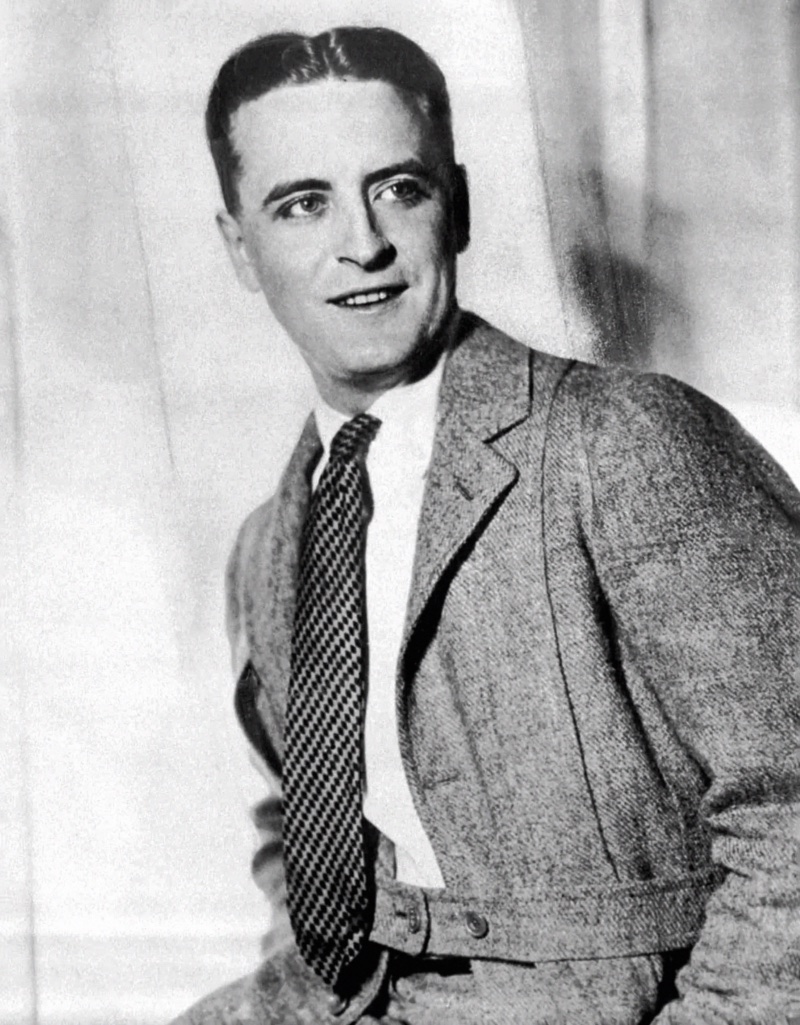
F. Scott Fitzgerald’s legacy extends beyond his literary masterpieces, with his sartorial choices making him a style icon. He cut a striking figure in finely tailored tweed suits, ascot ties or cravats, two-tone shoes, and spats, often accessorized with a fedora hat and walking stick.
While his books are cherished, his flair for fashion leaves an equally unforgettable mark, establishing him as a literary genius and a style connoisseur.
The 1920s in Pop Culture
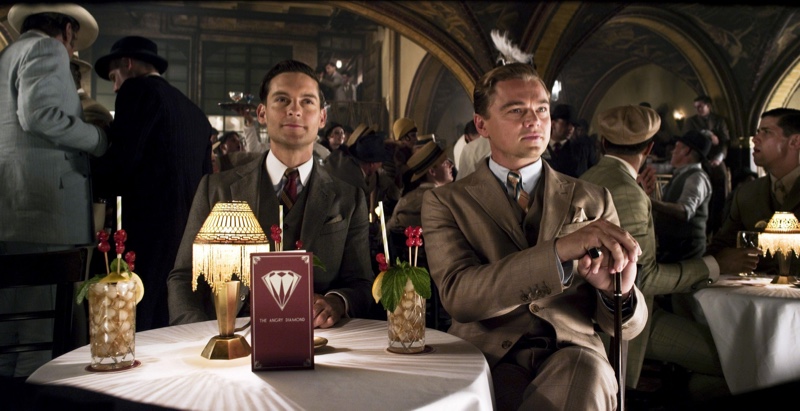
1920s men’s fashion inspires film and television, with shows like Boardwalk Empire and Peaky Blinders recreating the era’s signature styles, from tailored suits to flat caps and double-breasted jackets. The industry often relies on vintage patterns to meticulously recreate these enduring looks, underscoring the lasting influence of the decade’s fashion.
The Great Gatsby
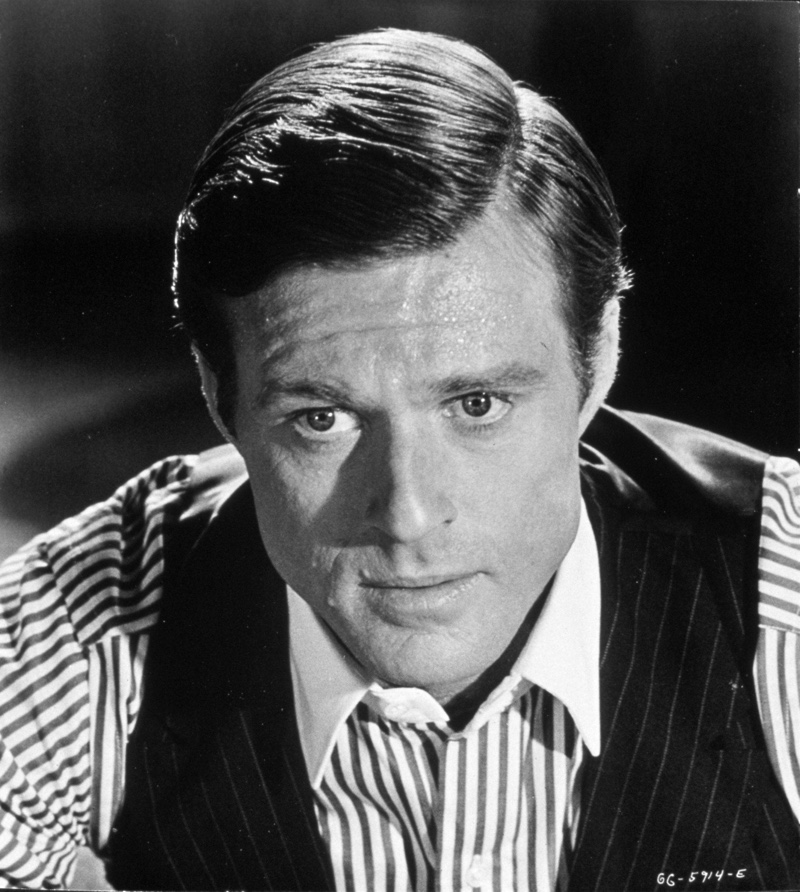
F. Scott Fitzgerald’s The Great Gatsby has been adapted for the screen multiple times since 1926, each offering a distinct take on 1920s men’s fashion. The 1974 film, directed by Jack Clayton, presents a subdued aesthetic with men in suits featuring wide lapels and double-breasted jackets in reserved earth tones like browns, tans, and grays, completed by pocket squares, hats, and ties.
This subtle portrayal captures the essence of the 1920s as an exercise in sophisticated restraint, emphasizing quality fabrics and impeccable tailoring reminiscent of screen icons like Douglas Fairbanks and Rudolph Valentino, in contrast to Baz Luhrmann’s flashier 2013 interpretation.
Fashion Style in Boardwalk Empire
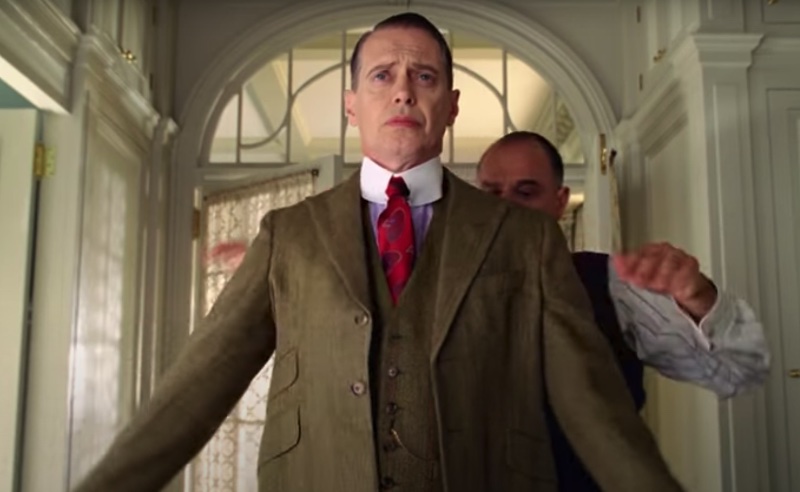
Boardwalk Empire transports viewers into the sartorial elegance of Atlantic City during the 1920s Prohibition era. Steve Buscemi’s character, Nucky Thompson, dons historically accurate vests and double-breasted suits crafted with an artisan’s eye for detail, drawing from genuine 1920s designs.
Costume designers used vintage patterns to ensure authenticity, making Thompson a character and a portrait of the era’s fashion.
Peaky Blinders Fashion Inspiration
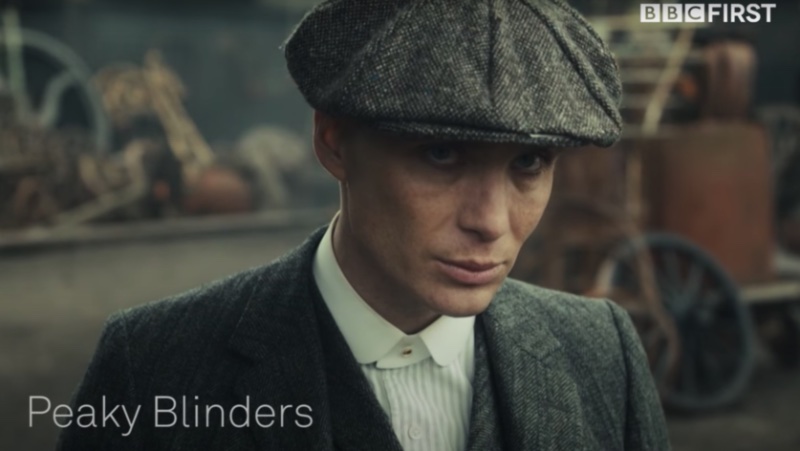
Peaky Blinders mesmerizes with its gripping narrative and accurate depiction of 1920s British men’s fashion, set in post-WWI Birmingham, England. Central to the story is Thomas Shelby, portrayed by Cillian Murphy, whose iconic style—characterized by the undercut hairstyle, flat caps, and sharp suits—embodies the era’s fashion.
The show meticulously integrates historical attire, from pocket watches to lapel pins, for aesthetics and to authentically represent the era’s blend of sophistication and boldness. Thus, it offers a deep dive into the fashion of that period while charting the exploits of a famed gangster family.
The Peaky Blinders haircut, featuring shaved sides and a longer top, has become popular today thanks to the show’s influence.
Downton Abbey
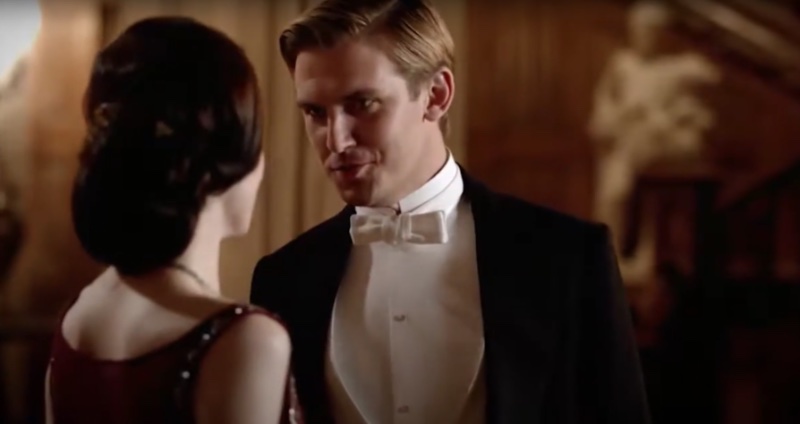
The third season of Downton Abbey immersed viewers in the 1920s, highlighting men’s fashion that merged necessity with elegance. The wardrobe illustrated the era’s sophistication by featuring sharp suits, detailed three-piece sets, and high-collared shirts with various cuff styles.
This season offered a historical glimpse into how 1920s fashion transcended mere trends to set the foundations of contemporary men’s attire.
What is 1920s Fashion? How to Apply It Today
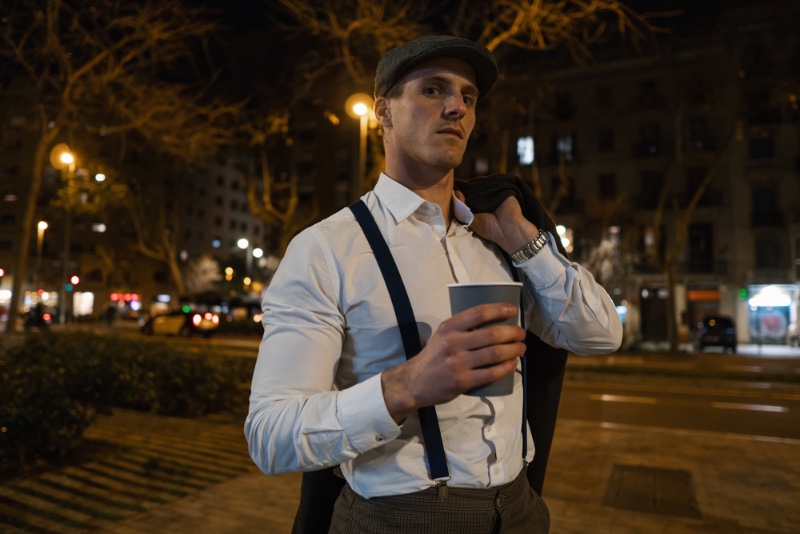
1920s fashion marked a pivotal shift towards sharp tailoring and elegance in men’s wear, highlighting tailored suits with clean lines that mirrored the era’s ambitions. Key pieces like double-breasted and three-piece suits became emblems of sophistication, further distinguished by vintage patterns.
Accessories were essential, transforming outfits into iconic statements. Pocket watches signified reliability, while lapel pins and ties added personal flair. Functional headwear, such as fedoras, flat caps, and versatile brogues, completed the classic 1920s ensemble.
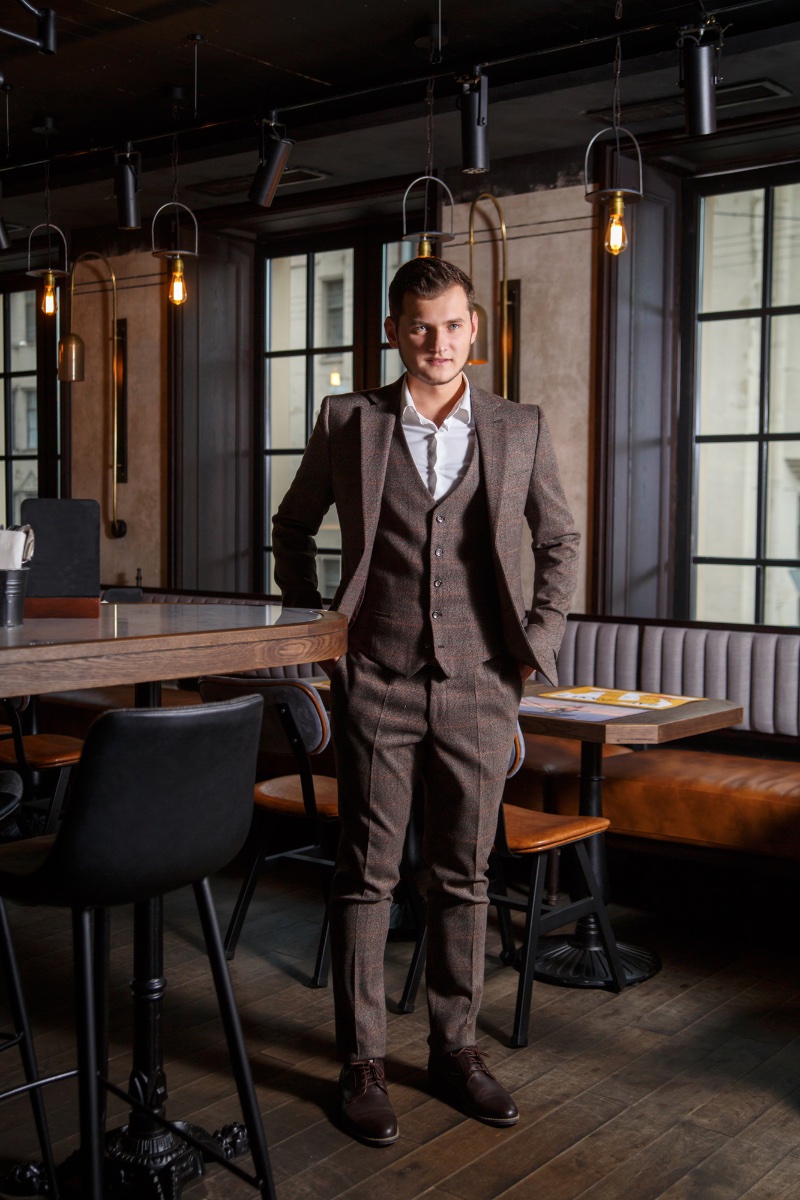
To adapt the 1920s style to today’s, focus on tailored garments that ensure a polished silhouette. Modernize with practical accessories like contemporary watches and stylish lapel pins.
Embrace the era’s mix of formality and personality through thoughtfully chosen headwear and footwear, blending timeless elegance with a modern twist.
The Legacy of 1920s Men’s Fashion
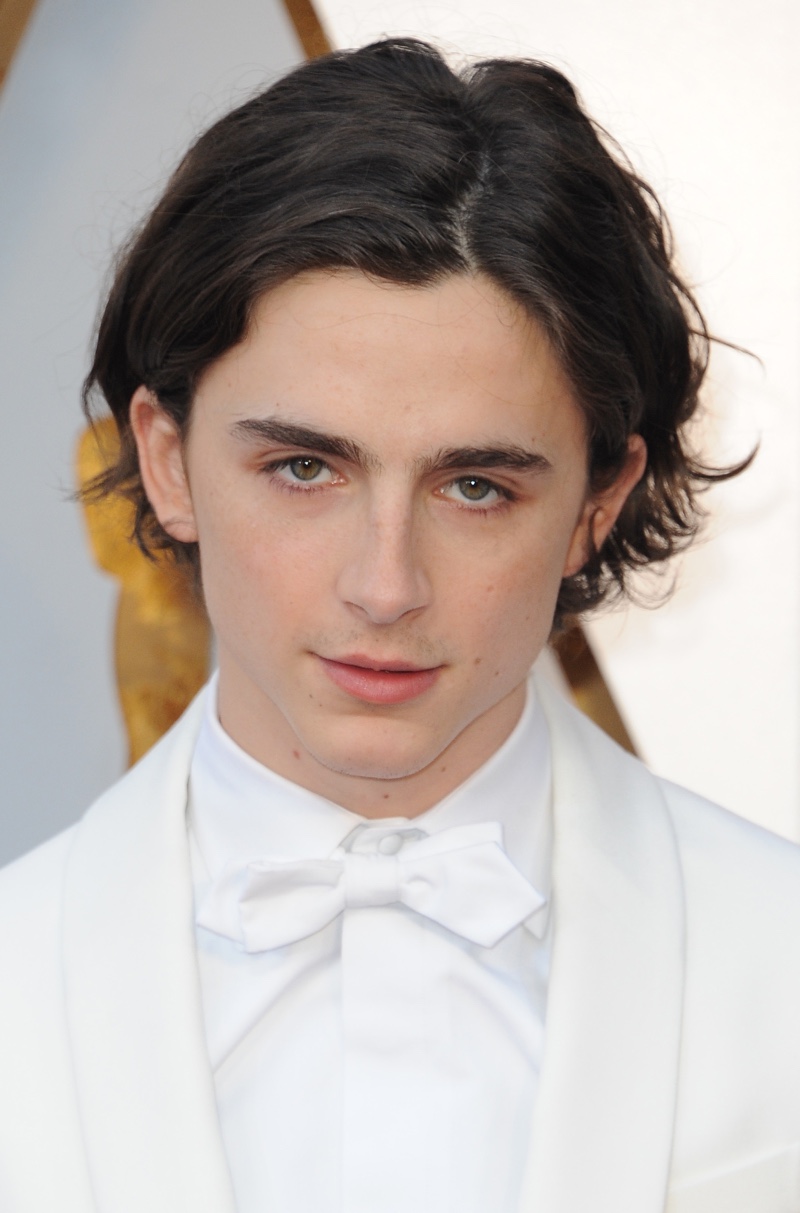
Icons like Douglas Fairbanks and Steve Buscemi’s Nucky Thompson from Boardwalk Empire have cemented the 1920s’ influence on today’s men’s fashion—a blend of precise tailoring and elegance. This era’s style extends beyond clothing; it’s a sartorial philosophy easily integrated into contemporary fashion without fully adopting a 1920s look.
Incorporating elements like a vintage pocket square with a modern suit or a sleek fedora with casual outfits can add a distinctive flair. These choices serve as conversation starters and link modern style with historical elegance, allowing for a timeless and personal fashion statement.
